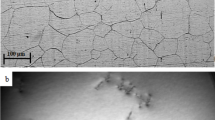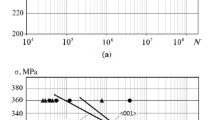Results of experimental studies of creep in a wide range of temperatures and stresses are presented for three modern single-crystal nickel-base alloys. A method for determining the creep characteristics by tests including step increase of the tension is suggested and tested. The effect of transition into plastic condition on the creep parameters, the influence of the chemical composition and loading conditions on the duration of creep stages I, II and III, and the conditions of appearance of crystallographic and not crystallographic modes of fracture are analyzed. Possible simple approximations of the creep curves are considered with allowance for the accumulation of damage and occurrence of unsteady creep stages.





Similar content being viewed by others
Notes
In the given form (without allowance for the damage) the equation was suggested for the first time in the work of Nadai in 1936; in the literature without references it is encountered in the books of Rabotnov (1966) and Taira (1979). Power dependences of creep rate on stresses have been suggested independently by Norton in 1929 and Bailey in 1929. Russian specialists know Eq. (1) as the “Taira model.”
References
R. E. Shalin, I. L. Svetlov, E. B. Kachanov, et al., Single Crystals of Nickel Refractory Alloys [in Russian], Mashinostroenie, Moscow (1997), 333 p.
E. R. Golubkovskii and I. L. Svetlov, “Temperature-time dependence of the anisotropy of long-term strength of single crystals of nickel refractory alloys,” Probl. Proch., 2, 5 – 19 (2002).
B. H. Kear and B. J. Piearcey, “Tensile and creep properties of single crystals of the nickel-base superalloy MAR-M200,” Trans. Met. Soc. AIME, 239, 1209 – 1215 (1967).
R. A. MacKay and R. D. Mailer, “The influence of orientation on the stress rupture properties of nickel-base superalloy single crystals,” Metall. Trans., 13A(10), 1747 – 1754 (1982).
P. Caron, Y. Ohta, Y. G. Nakagawa, and T. Khtan, “Creep deformation anisotropy in single crystal Ni-base superalloy,” in: Superalloy’88 (1988), pp. 215 – 225.
T. M. Pollock and A. S. Argon, “Creep resistance of CMSX-3 nickel base superalloy single crystals,” Acta Metall. Mater., 40(1), 1 – 30 (1992).
C. K. Bullough, M. Toulios, M. Oehl, and P. Lukas, “The characterization of the single crystal superalloy CMSX-4 for industrial gas turbine blading applications,” in: Proc. 6th Conf. “Materials for Advanced Power Engineering 1998,” Liege (1998), pp. 861 – 978.
D. W. MacLachlan, L. W. Wright, S. S. K. Gunturi, and D. M. Knowles, “Modeling the anisotropic and biaxial creep behaviour of Ni-base single crystal superalloys CMSX-4 and SRR99 at 1223 K,” in: T. M. Pollock, R. D. Kissinger, R. R. Bowman, et al. (eds.), Proc. of the Superalloys 2000 (2000), pp. 357 – 366.
Y. Nakagawa, H. Terashima, H. Yoshizawa, et al., “Elevated temperature strength anisotropy of precipitation hardening single crystals Ni-base superalloys,” Harima GIHO, 25(1), 5 – 10 (1985).
M. G. Hebsur and R. V. Miner, “Elevated temperature tension, compression, and creep-rupture behavior of [001]-oriented single crystal superalloy PWA 1480,” in: NASA Technical Memorandum 88950 (1987), 11 p.
M. V. Nathal and L. J. Ebert, “Elevated temperature creep rupture behavior of the single crystal nickel-base superalloy NASAIR-100,” Metall. Trans., 16A(3), 427 – 439 (1985).
P. Caron, “High γ′ solvus new generation nickel-based superalloys for single crystal turbine blade applications,” in: T. M. Pollock, R. D. Kissinger, R. R. Bowman, et al. (eds.), Proc. of the Superalloys 2000 (2000), pp. 737 – 746.
A. Raffaitin, D. Monceau, F. Crabos, and E. Andrieu, “The effect of thermal cycling on the high-temperature creep behaviour of a single crystal nickel-based superalloy,” Scr. Mater., 56, 277 – 280 (2007).
R. A. MacKay, T. P. Gabb, and M. V. Nathal, Effects of Microstructural Parameters of Creep of Nickel-Base Superalloy Single Crystals, NASA / TM-2013-217868, 27 p.
M. N. Stepnov, E. R. Golubovskii, I. A. Inozemtseva, et al., “Characteristics of long-term strength single-crystal materials,” Probl. Proch., No. 2, 35 – 39 (1993).
E. R. Golubovskii, I. L. Stepnov, and K. K. Khvatskii, “Laws of axial and azimuthal anisotropy of strength characteristics of single crystals of refractory nickel alloys for GTE blades,” Aviats.-Kosm. Tekh. Tekhnol., No. 10/26, 50 – 54 (2005).
L. B. Getsov, A. I. Rybnikov, A. S. Semenov, et al., “Deformation and fracture resistance of single-crystal alloys under static and thermal cycle loading,” Nadezh. Bezopas. Energ., No. 3(18), 53 – 62 (2012).
E. I. Kablov, N. V. Petrushin, I. L. Svetlov, and I. M. Demonis, “Nickel castable refractory alloys of a new generation,” in: Aviation Materials and Technologies, Proc. of VIAM [in Russian], Moscow (2012), pp. 36 – 52.
V. N. Toloraya, H. G. Orekhov, and E. N. Chubarova, “Carbonless Re-containing nickel alloys for turbine blades,” Liteinoe Proizvod., No. 6, 25 – 30 (2012).
L. Getsov, A. Semenov, and A. Staroselsky, “A failure criterion for single-crystal superalloys during thermocyclic loading,” Mater. Tehnologije, 42(1), 3 – 12 (2008).
L. Getsov, A. Rybnikov, and A. Semenov, “Ratcheting of high temperature materials at thermal cyclic loading,” in: 17th Eur. Conf. on Fracture: Multilevel Approach to Fracture of Materials, Components and Structures (2008), pp. 1111 – 1119.
L. B. Getsov, N. I. Dobina, A. I. Rybnikov, et al., “Thermal fatigue resistance of a single-crystal alloy,” Probl. Prochn., No. 5, 54 – 71 (2008).
L. B. Getsov, A. I. Rybnikov, and A. S. Semenov, “Thermal fatigue resistance of refractory alloys,” Teploenergetika, No. 5, 51 – 58 (2009).
A. Semenov, S. Semenov, A. Nazarenko, and L. Getsov, “Computer simulation of fatigue, creep and thermal-fatigue cracks propagation in gas-turbine blades,” Mater. Tehnologije, 46(3), 197 – 203 (2012).
K. N. Kablov, V. N. Toloraya, and N. G. Orekhov, “Single-crystal nickel rhenium-containing alloys for turbine blades of GTE,” Metalloved. Term. Obrab. Met., No. 7, 7 – 11 (2002).
L. B. Getsov, Materials and Strength of Gas Turbine Parts, Book 1 [in Russian], Izd. Dom “Gazoturbinnye Tekhnologii,” Rybinsk (2010), 595 p.
L. B. Getsov, A. S. Semenov, E. A. Tikhomirova, and A. I Rybnikov, “Thermocyclic and static failure criteria for single-crystal superalloys of gas-turbine blades,” Mater. Tehnologije, 48(2), 255 – 260 (2014).
B. F. Dyson and T. B. Gibbons, “Tertiary creep in nickel-base superalloys: analysis of experimental data and theoretical synthesis,” Acta Metall. Mater., 35(9), 2355 – 2369 (1987).
N. A. Katanakha, A. S. Semenov, and L. B. Getsov, “Single model of long-term and short-term creep and identification of its parameters,” Probl. Prochn., No. 4, 143 – 157 (2013).
N. A. Katanakha, A. S. Semenov, and L. B. Getsov, “Endurance of bends of high-temperature steam conduits under long-term operation,” Teploenergetika, No. 4, 32 – 42 (2014).
J. Cormier, X. Milhet, J. Mendez, and G. Cailletaud, “Modeling the [001] non-isothermal creep behavior of a second generation single crystal Ni-based superalloy submitted to very high temperature overheat,” Trudy TsKTI, 296, 199 – 215 (2009).
J. Besson, G. Cailletaud, J.-L. Chaboche, and S. Forest, Nonlinear Mechanics of Materials [Russian translation], Izd. Politekhn. Univ., St. Petersburg (2010), 398 p.
A. S. Semenov and L. B. Getsov, “Criteria of thermal fatigue fracture of single-crystal refractory alloys and method of determination of their parameters,” Probl. Prochn., No. 1, 50 – 62 (2014).
A. Staroselsky and B. N. Cassenti, “Creep, plasticity and fatigue of single crystal superalloy,” Int. J. Solids Struct., 48, 945 – 959 (2011).
R. M. Obodai-Fard, A. S. Semenov, and L. B. Getsov, “Modeling of processes of inelastic deformation of specimens of single-crystal materials with allowance for dislocation dynamics,” in: XL Week of Science at SPbGPU, Materials of Int. Workshop [in Russian], St. Petersburg (2011), Part V, pp. 72 – 73.
J. Preuβner, Y. Rudnik, H. Brehm, R. Völkl, and U. Glatzel, “A dislocation density based material model to simulate the anisotropic creep behavior of single-phase and two-phase single crystals,” Int. J. Plasticity, 25, 973 – 994 (2009).
Author information
Authors and Affiliations
Corresponding author
Additional information
Translated from Metallovedenie i Termicheskaya Obrabotka Metallov, No. 12, pp. 29 – 37, December, 2015.
Rights and permissions
About this article
Cite this article
Semenov, S.G., Getsov, L.B., Tikhomirova, E.A. et al. Special Features of Creep and Long-Term Strength of Single-Crystal Refractory Nickel-Base Alloys. Met Sci Heat Treat 57, 731–738 (2016). https://doi.org/10.1007/s11041-016-9950-6
Published:
Issue Date:
DOI: https://doi.org/10.1007/s11041-016-9950-6




